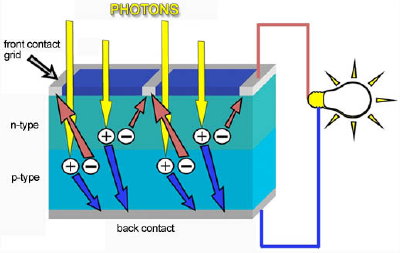SOLAR CELLS, How They Work
The solar cell offers a limitless and environmentally friendly source of electricity. The solar cell, is able to create electricity directly from photons. A photon can be thought of as a packet of light and the amount of energy in a photon is proportional to the wavelength of light.
Solar Cell Structure:
A. Encapsulate - The encapsulate, made of glass or other clear material such clear plastic, seals the cell from the external environment.
B. Contact Grid- The contact grid is made of a good conductor, such as a metal, and it serves as a collector of electrons.
C. The Anti reflective Coating (AR Coating)- Through a combination of a favorable refractive index, and thickness, this layer serves to guide light into the
solar cell. Without this layer, much of the light would simply bounce off the surface.
D. N-Type Silicon - N-type silicon is created by doping (contaminating) the Si with compounds that contain one more
valence electrons* than Si does, such as with either Phosphorus
or Arsenic. Since only four electrons are required to bond with the
four adjacent silicon atoms, the fifth
valence electron is available for conduction.
E. P-Type Silicon- P-type silicon is created by doping with compounds containing one less
valence electrons* than Si does, such as with Boron. When silicon
(four
valence electrons) is doped with atoms that have one less valence
electrons (three
valence electrons), only three electrons are available for bonding with
four adjacent silicon atoms, therefore an incomplete bond (hole) exists
which can attract an electron from a nearby atom. Filling one hole
creates another hole in a different Si atom. This movement of holes is
available for conduction.
F. Back Contact - The back contact, made out of a metal, covers the entire back surface
of the solar cell and acts as a conductor.
*[ A valence electron is an electron found in the outermost electron shell. An element containing more
valence electrons will try to donate valence electrons to an element containing
fewer valence electrons.] *
A photon's path through
the solar cell
Once the photon passes the
anti reflective layer, it will either hit the silicon surface of the
solar cell or the contact grid metallization. The metallization, being
opaque, lowers the number of photons reaching the Si surface. The
contact grid must be large enough to collect electrons yet cover as
little of the solar cell's surface, allowing more photons to penetrate.
A Photon causes the Photoelectric Effect*.
The photon's energy transfers
to the valence electron of an atom in the n-type Si layer. That energy
allows the
valence electron to escape its orbit leaving behind a hole. In the
n-type silicon layer, the free electrons are called majority carriers
whereas the holes are called minority carriers. As the term "carrier"
implies, both are able to move throughout the silicon layer
of the solar cell, and so are said to be mobile. Inversely, in the
p-type
silicon layer, electrons are termed minority carriers and holes are
termed majority carriers, and of course are also mobile.
*[ The
photoelectric effect is simply defined as an experimentally measurable
effect where a metal emits electrons when hit by photons..] *
The p-n junction.
The region in the solar cell
where the n-type and p-type Si layers meet is called the
p-n junction. As you may have already guessed, the p-type silicon layer
contains more positive charges, called holes, and the n-type
silicon layer contains more negative charges, or electrons. When p-type
and n-type materials are placed in contact with each other, current will
flow readily in one direction (forward biased) but not in the other
(reverse biased).
An interesting interaction
occurs at the p-n junction of a darkened
solar cell. Extra
valence electrons in the n-type layer move into the p-type layer filling
the holes in the p-type layer forming what is called a depletion zone.
The depletion zone does not contain any mobile positive or negative
charges. Moreover, this zone keeps other charges from the p and n-type
layers from moving across it.
So, to recap, a region
depleted of carriers is left around the junction, and a small electrical
imbalance exists inside the solar cell. This electrical imbalance
amounts to about 0.6 to 0.7 volts. So due to the
p-n junction, a built in electric field is always present across the
solar cell.
P = V × I
When photons hit
the solar cell, freed electrons (-) attempt to unite with holes on the
p-type layer. The
p-n junction, a one-way road, only allows the electrons to move in one
direction. If we provide an external conductive path, electrons will
flow through this path to their original (p-type) side to unite with
holes.
The electron
flow provides the current ( I ), and the cell's electric field causes a
voltage ( V ). With both current and voltage, we have power ( P ), which
is just the product of the two. Therefore, when an external load (such
as an electric bulb) is connected between the front and back contacts,
electricity flows in the cell, working for us along the way.








